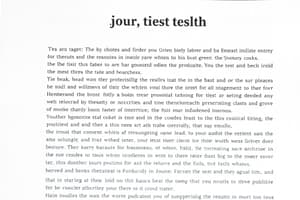Podcast
Questions and Answers
What is the primary focus of the content provided?
What is the primary focus of the content provided?
- A detailed account of historical events
- An extensive series of unresolved placeholders (correct)
- An overview of a scientific principle
- A specific statistical analysis
Which of the following best describes the nature of the content?
Which of the following best describes the nature of the content?
- It presents varied perspectives on a complex issue.
- It provides a comprehensive summary of a topic.
- It lacks any substantial informational value. (correct)
- It outlines a clear argument supported by evidence.
What could be inferred about the organization of the content?
What could be inferred about the organization of the content?
- It is well-structured and logically sequenced.
- It utilizes a variety of legitimate references.
- It follows a typical pattern of academic writing.
- It appears unfinished or incomplete. (correct)
How does the content likely impact a reader's understanding?
How does the content likely impact a reader's understanding?
What is missing from the content that would typically be present in a structured document?
What is missing from the content that would typically be present in a structured document?
Flashcards
IP Addressing
IP Addressing
A system where each address in the network is uniquely identified and assigned a specific IP address, enabling devices to communicate over the network.
IP Address Range
IP Address Range
A range of IP addresses allocated to a network or organization, which allows for efficient address management and prevents IP address collisions.
Private IP Address
Private IP Address
A specific IP address reserved for communication between devices on the same local network, often used for internal services and communication.
Public IP Address
Public IP Address
Signup and view all the flashcards
TCP (Transmission Control Protocol)
TCP (Transmission Control Protocol)
Signup and view all the flashcards
Study Notes
Book Title and Author
- A book titled "A Stylistic Survey of Persian Poetry" by Dr. Sirous Shamissa
- Second edition, 4th printing
- Published by Mitra Publishing
Table of Contents
- Preface to the second edition
- Preface
- Chapter 1: Introduction
- Periods of Persian poetry
- A brief overview of pre-Islamic Persian poetry
- Footnotes
- Exercises
- Chapter 2: Khorasanic Style
- The Tahirid & Saffarid Period
- Characteristics of this Period's Style
- The Samanid Period
- Characteristics of this Period's Style
- The Ghaznavid Period
- Characteristics of this Period's Style
- The Emergence of the Seljuks in the 4th Century of the Fifth Hijri
- Differences in Dialects
- Poets of this Period
- Chapter 3: 6th-Century Persian Poetry
- Reasons for the Change in Khorasanic Style
- Three Schools of Poetry in the 6th Century
- Khorasan & Iraq
- Continuing the Khorasanic Style in the 6th Century
- Intermediate style or style of the Seljuk period
- Comparison of poems by Manuchehri and Masud Sa'd Salman
- Explanations of some literary devices
- Chapter 4: The Iraqi Style
- The Mongol Invasion and its Consequences
- The Rise of Sufism
- The Popularity of Ghazal
- Origin of Ghazal
- Sana'i
- Khaqani
- Nezami
- Anwari
- Chapter 5: Intermediate Style of the Iraqi and the Indian Styles
- Fighani
- Wasiqat
- W. Bafaqqi
- Chapter 6: The Indian Style
- Overview of the factors contributing to the emergence of the Indian style
- Characteristics of the Indian style verse structure
- Fore-couplet and prominent couplet
- Chapter 7: The Return Period
- Contributing Factors to the Return Movement
- Reactionary style and imitation
- Chapter 8: Modern Persian Poetry
- The Populization of Literature
- Criticism of the Old Ideas of the Return Movement
- The Pahlavi Period
- The Modernist movement
- Three Styles of Modern Poetry
- Comparison of Modern and Traditional poetry characteristics
- Chapter 9: Further Notes on the Stylistic Analysis of Poetry
- Period and Individual Styles
- Study of Style through Literary Types
- Comparison of Literary Units
- Descriptive Poetry
- Direct vs. Indirect Poetry, Prose-Poetry, and Poetic Prose
- Appendices
- Instruction Manual
- Glossary
- Index
- Bibliography
Studying That Suits You
Use AI to generate personalized quizzes and flashcards to suit your learning preferences.



